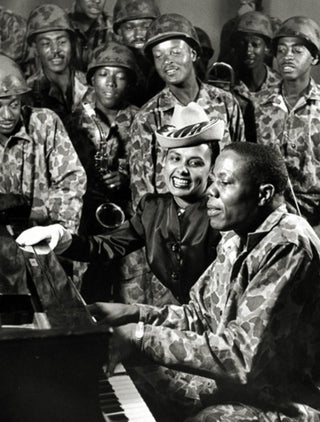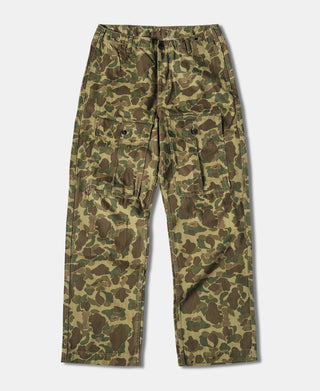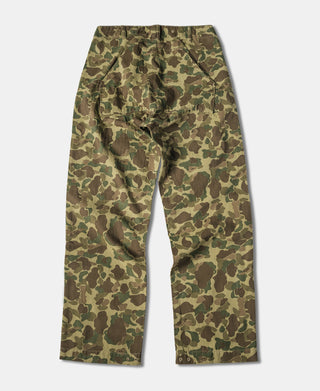US Army M-1943 Herringbone Cotton Camouflage Pants (Modified)
- Stückpreis
- /per
Free Shipping over £79 + 30-day Returns.
Model
- 5' 10", 159lbs / 178cm, 72.5kg. Size W31.
Pairs well with
Produkt in den Warenkorb legen
-
In early 1943, the Army produced a small number of split two-piece Herringbone (HBT) duck hunting camouflage uniforms, based on the M-1942 HBT work uniform, with standardized pants of simple design for ease of production, with a storage pocket on each thigh and adjustable drawstrings at the legs.
Bronson's version is based on the historical data and envisioned a "modified version of the frog skin camouflage pants", equipped for armored units in the Eastern Theater of Operations, adjusted to the framework of the M-43 camouflage pants, with the addition of practical side pockets, storage pockets on the front side, and a kangaroo pocket on the hips for easy access to the goods. High rise, loose silhouette for substantial movement, and round holes in the legs of the pants for string or wire, and for drying after washing.
The combat suit has to meet the functional requirements, including the function of storage and easy access to items. Our alterations everywhere are designed to be well thought out and make practical sense, with no unnecessary and pointless designs. -
**Model - 5' 10", 159lbs / 178cm, 72.5kg. Size W31.**
Please use this info as a general guide as measurements are approximate.
Size Waist Hip W29 28.3" / 72 cm 40.1" / 102 cm W30 29.5" / 75 cm 41.3" / 105 cm W31 30.7" / 78 cm 42.5" / 108 cm W32 32.3" / 82 cm 43.7" / 111 cm W34 34.6" / 88 cm 45.6" / 116 cm W36 35.8" / 91 cm 47.2" / 120 cm W38 37" / 94 cm 48.8" / 124 cm
Size Front Rise Back Rise W29 12.4" / 31.5 cm 16.1" / 41 cm W30 12.8" / 32.5 cm 16.5" / 42 cm W31 13" / 33 cm 16.9" / 43 cm W32 13.2" / 33.5 cm 17.3" / 44 cm W34 13.8" / 35 cm 17.5" / 44.5 cm W36 14.2" / 36 cm 17.7" / 45 cm W38 14.6" / 37 cm 18.1" / 46 cm
Size Thigh Inseam W29 26" / 66 cm 30" / 76 cm W30 26.8" / 68 cm 30.3" / 77 cm W31 27.6" / 70 cm 30.7" / 78 cm W32 28" / 71 cm 31.1" / 79 cm W34 28.7" / 73 cm 31.5" / 80 cm W36 29.5" / 75 cm 31.9" / 81 cm W38 30.7" / 78 cm 32.3" / 82 cm
Size Length Leg Opening W29 40.9" / 104 cm 18.1" / 46 cm W30 41.7" / 106 cm 18.5" / 47 cm W31 42.5" / 108 cm 18.9" / 48 cm W32 43.3" / 110 cm 19.3" / 49 cm W34 44" / 112 cm 19.9" / 50.5 cm W36 44.5" / 113 cm 20" / 51 cm W38 45.3" / 115 cm 20.5" / 52 cm In order to best determine fit, it may be helpful to compare our garment’s measurements to a similar garment you already own. Lay your garment on a flat surface and take all measurements from the outside of the garment.
Click here to check out our Garment Measuring Guide.
** If you are still confused, you can Contact Us to help you choose the size. **
-
- Loose fit with a straight leg and high rise.
- Belt loops. Button fly.
- Two front angled pockets. Storage pockets on the front thigh. Kangaroo pocket on the hips.
- 10 oz. cotton herringbone, 100% cotton.
- Machine washable.
-
- Machine washable.
In early 1943, the Army produced a small number of split two-piece Herringbone (HBT) duck hunting camouflage uniforms, based on the M-1942 HBT work uniform, with standardized pants of simple design for ease of production, with a storage pocket on each thigh and adjustable drawstrings at the legs.
Bronson's version is based on the historical data and envisioned a "modified version of the frog skin camouflage pants", equipped for armored units in the Eastern Theater of Operations, adjusted to the framework of the M-43 camouflage pants, with the addition of practical side pockets, storage pockets on the front side, and a kangaroo pocket on the hips for easy access to the goods. High rise, loose silhouette for substantial movement, and round holes in the legs of the pants for string or wire, and for drying after washing.
The combat suit has to meet the functional requirements, including the function of storage and easy access to items. Our alterations everywhere are designed to be well thought out and make practical sense, with no unnecessary and pointless designs.
Please use this info as a general guide as measurements are approximate.
| Size | Waist | Hip |
| W29 | 28.3" / 72 cm | 40.1" / 102 cm |
| W30 | 29.5" / 75 cm | 41.3" / 105 cm |
| W31 | 30.7" / 78 cm | 42.5" / 108 cm |
| W32 | 32.3" / 82 cm | 43.7" / 111 cm |
| W34 | 34.6" / 88 cm | 45.6" / 116 cm |
| W36 | 35.8" / 91 cm | 47.2" / 120 cm |
| W38 | 37" / 94 cm | 48.8" / 124 cm |
| Size | Front Rise | Back Rise |
| W29 | 12.4" / 31.5 cm | 16.1" / 41 cm |
| W30 | 12.8" / 32.5 cm | 16.5" / 42 cm |
| W31 | 13" / 33 cm | 16.9" / 43 cm |
| W32 | 13.2" / 33.5 cm | 17.3" / 44 cm |
| W34 | 13.8" / 35 cm | 17.5" / 44.5 cm |
| W36 | 14.2" / 36 cm | 17.7" / 45 cm |
| W38 | 14.6" / 37 cm | 18.1" / 46 cm |
| Size | Thigh | Inseam |
| W29 | 26" / 66 cm | 30" / 76 cm |
| W30 | 26.8" / 68 cm | 30.3" / 77 cm |
| W31 | 27.6" / 70 cm | 30.7" / 78 cm |
| W32 | 28" / 71 cm | 31.1" / 79 cm |
| W34 | 28.7" / 73 cm | 31.5" / 80 cm |
| W36 | 29.5" / 75 cm | 31.9" / 81 cm |
| W38 | 30.7" / 78 cm | 32.3" / 82 cm |
| Size | Length | Leg Opening |
| W29 | 40.9" / 104 cm | 18.1" / 46 cm |
| W30 | 41.7" / 106 cm | 18.5" / 47 cm |
| W31 | 42.5" / 108 cm | 18.9" / 48 cm |
| W32 | 43.3" / 110 cm | 19.3" / 49 cm |
| W34 | 44" / 112 cm | 19.9" / 50.5 cm |
| W36 | 44.5" / 113 cm | 20" / 51 cm |
| W38 | 45.3" / 115 cm | 20.5" / 52 cm |
In order to best determine fit, it may be helpful to compare our garment’s measurements to a similar garment you already own. Lay your garment on a flat surface and take all measurements from the outside of the garment.
Click here to check out our Garment Measuring Guide.
** If you are still confused, you can Contact Us to help you choose the size. **
- Loose fit with a straight leg and high rise.
- Belt loops. Button fly.
- Two front angled pockets. Storage pockets on the front thigh. Kangaroo pocket on the hips.
- 10 oz. cotton herringbone, 100% cotton.
- Machine washable.
- Machine washable.

In response to combat needs, the U.S. Army Engineering Department began to develop camouflage clothing in 1940, designed by California civilian horticulturist Norvell Gillespie (Norvell Gillespie), one side of the five-color green system for jungle environment, the other side of the three-color tan system for desert environment. This pattern was applied to Herringbone Twill fabrics for printing and dyeing and for making combat suits. At this point, camouflage patterns began to be applied to American military clothing, and were also widely used in outdoor hunting and other clothing after the war, and inspired many designers to re-create and then influence the fashion world.
















